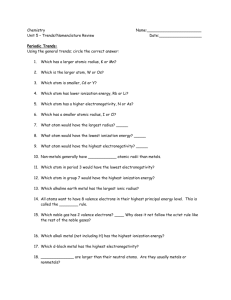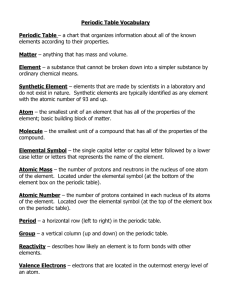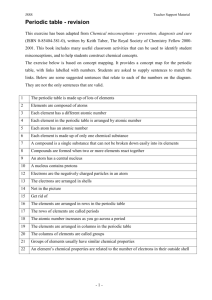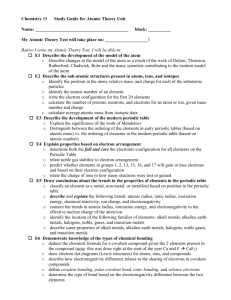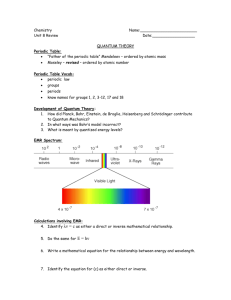b. matching
advertisement
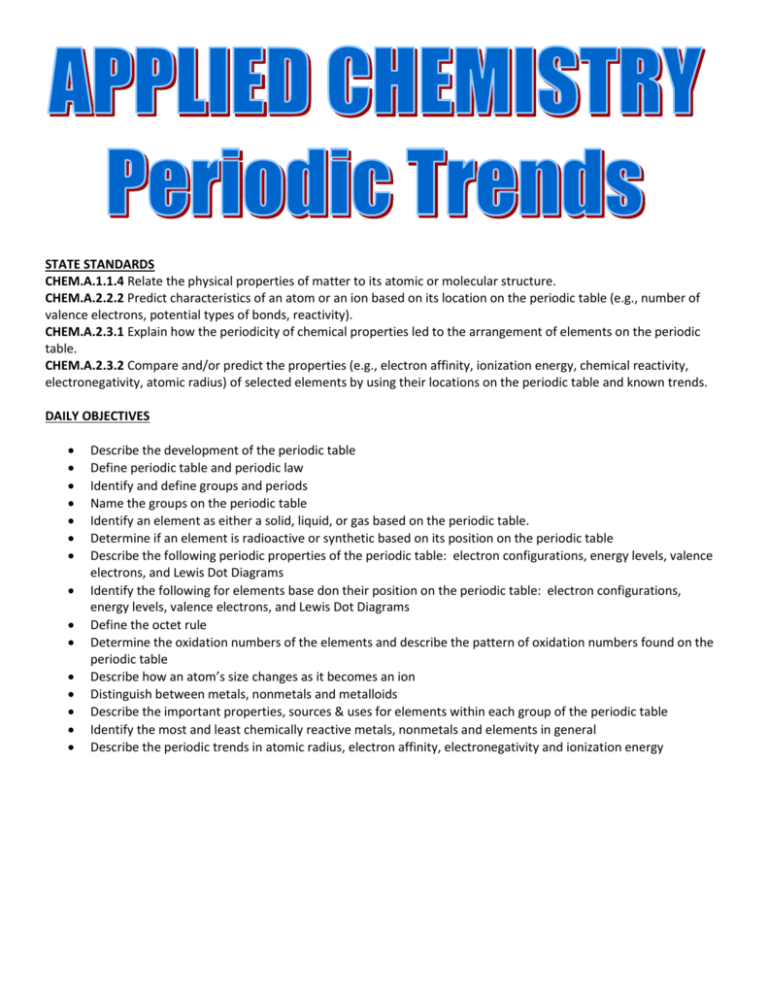
STATE STANDARDS CHEM.A.1.1.4 Relate the physical properties of matter to its atomic or molecular structure. CHEM.A.2.2.2 Predict characteristics of an atom or an ion based on its location on the periodic table (e.g., number of valence electrons, potential types of bonds, reactivity). CHEM.A.2.3.1 Explain how the periodicity of chemical properties led to the arrangement of elements on the periodic table. CHEM.A.2.3.2 Compare and/or predict the properties (e.g., electron affinity, ionization energy, chemical reactivity, electronegativity, atomic radius) of selected elements by using their locations on the periodic table and known trends. DAILY OBJECTIVES Describe the development of the periodic table Define periodic table and periodic law Identify and define groups and periods Name the groups on the periodic table Identify an element as either a solid, liquid, or gas based on the periodic table. Determine if an element is radioactive or synthetic based on its position on the periodic table Describe the following periodic properties of the periodic table: electron configurations, energy levels, valence electrons, and Lewis Dot Diagrams Identify the following for elements base don their position on the periodic table: electron configurations, energy levels, valence electrons, and Lewis Dot Diagrams Define the octet rule Determine the oxidation numbers of the elements and describe the pattern of oxidation numbers found on the periodic table Describe how an atom’s size changes as it becomes an ion Distinguish between metals, nonmetals and metalloids Describe the important properties, sources & uses for elements within each group of the periodic table Identify the most and least chemically reactive metals, nonmetals and elements in general Describe the periodic trends in atomic radius, electron affinity, electronegativity and ionization energy APPLIED CHEMISTRY PERIODIC TRENDS DAILY PLANNER Day Classwork 1 Fri. 3/16 2 3 Tues. 3/18 4 Notes: Trends in Valence Electrons, Oxidation Numbers, Highest Energy Levels & Electron Configurations Notes: Trends in Atomic Size & Ion Size Vocabulary Quiz (20 Points) Notes: Ionization Energy & Electronegativity Chemical Reactivity Lab (15 Points) Notes: Chemical Reactivity Element Research & Element Key Design (30 Points) Notes: Alkali, Alkaline Earth, Transition & Inner Transition Metals Notes: Boron, Carbon, Nitrogen & Oxygen Groups Notes: Halogens & Noble Gases Notes & Homework Packets Due (50 Points) Review for Test Go over Packets Review Game Test on Periodic Trends 5 6 7 8 9 Wed. 3/28 10 11 Fri. 3/30 Homework HW1: Worksheet A HW2: Worksheet B HW3: Worksheet C HW4: Worksheet D Finish today’s work. Element Key due Tomorrow HW5: Worksheet E HW6: Worksheet F HW7: Worksheet G Study for Test Study for Test CONGRATULATIONS TO THE FOLLOWING PAIRS FOR HAVING THE HIGHEST AVERAGES FOR THE ELECTRON CONFIGURATION CHAPTER Period 1: Matt Aiken & Anthony Granato Period 2: Joey Bales & Drew Fehlinger Period 8: Veronica Augello & Lauren Mengel HOMEWORK GRADE A 35/35 B 32/35 C 28/35 D 25/35 F 21/35 No Grade 0/35 7/7 Homeworks Complete 6/7 Homeworks Complete 5/7 Homeworks Complete 4/7 Homeworks Complete 3.5/7 Homeworks Complete Less than ½ of Homework Complete (<3.5/7) PACKET GRADE A 25/25 B 21/25 C 19/25 D 17/25 F 15/25 No Grade 0/25 All notes/ATB’s/Before you Leaves Complete Missing 1-3 ATB’s or BYL’s All notes complete Missing 1 section of notes Or 3-6 ATB’s or BYL’s Missing 2 sections of notes or 6 or more ATB’s or BYL’s ¼ to ½ of the notes/ATB’s and BYL’s are incomplete More than ½ of the notes/ATB’s and BYL’s are incomplete EXTRA CREDIT 4 Points: Worksheet H 3 Points: Worksheet I 9 Points: Worksheet J 9 Points: Determine which elements are responsible for the following paint colors and create a poster to display your information: Red, Orange, Yellow, White, Blue, Green and Violet Periodic Trend: 1) Electron Configurations o Representative elements: s-block: p-block: o Transition Elements d-block: o Inner-Transition Elements f-block: 2) Highest Energy Level: Practice Problems What is the highest energy level of each of the following elements? a) Titanium ____________ b) sulfur _____________ c) cesium ____________ d) californium _____________ 3) Valence Electrons: o Pattern for the # of valence electrons within the representative elements Group 1 2 13 14 15 16 17 18 o Transition Metals: Exceptions Silver is always _________________ Zinc is always __________________ o Inner Transition Metals: Practice Problems How many valence electrons does each of the following elements have? a) phosphorus____________________ b) calcium _____________________ c) zinc d) fluorine _____________________ ____________________ 4) Lewis Dot Diagrams: Practice Problems Draw the Lewis Dot Diagram for each of the following elements. a) Iodine __________________________ b) Aluminum ________________________ c) Xenon __________________________ d) Silver ________________________ 5) Oxidation Number: If an element loses electrons, its oxidation # is a ___________________ number. Cation: o Elements with 1-3 valence electrons: If an element gains electrons, its oxidation # is a __________________ number. Anion: o Elements with 5-8 valence electrons: o Elements with 4 valence electrons: o Transition Metals: o Inner Transition Metals: BEFORE YOU LEAVE Complete the following table: Element Magnesium Chlorine Nitrogen # of Valence Electrons Highest Energy Level Oxidation Number Lewis Dot Diagram WORKSHEET A 1. A charged atom is called an ___________________________. 2. Write the number of valence electrons for each of the following elements. a) Si __________ b) Ar ___________ c) Bi ___________ d) Ca _________ 3. Draw dot diagrams for each of the following elements. a) aluminum ______________________ b) barium __________________________ c) bromine ______________________ d) potassium __________________________ 4. What ion is formed when (an example has been done for you)? a) a sulfur atom gains two electrons? _________________S-2_________________ b) an aluminum atom loses 3 electrons? __________________________________ c) an iodine atom gains 1 electron? __________________________________ d) a magnesium atom loses 2 electrons? __________________________________ 5. What is the oxidation number of each of the following elements (an example has been done for you)? a) lithium _______+1_____________ b) sulfur _______________________ c) fluorine _____________________ d) magnesium _______________________ e) cerium _____________________ f) silver _______________________ 6. Identify each of the following as either an anion, cation or an atom. Write the correct answer on the line. a) Ne _____________________ b) Mn4+ ________________________ c) N3- _____________________ d) N ________________________ e) Cl - _____________________ f) Na + ________________________ 7. Complete the following table. Element Hydrogen Group # Period # 1 1 1 4 Highest # of Valence Lewis Dot Energy Level Electrons Diagram 1 1 H 4 3 Oxidation # +1 Helium 3 Phosphorus -1 ATB1 According to this graph, what would be the approximate atomic radius of aluminum? 6) Atomic Size: Moving across a period, the atomic size ______________________________________ because: Moving down a group, the atomic size _______________________________________ because: Practice Problems Identify which element in each pair is larger. a) sodium or aluminum _______________________ b) beryllium or strontium ____________ c) Ge or C _______________________ d) Kr or K ____________ 7) Ionic Size: If an atom loses electrons, its size becomes: Because: Therefore, a positive ion would be ______________________ than its corresponding atom. __________________________ lose electrons easily, therefore, they typically acquire negative charges. If an atom gains electrons, its size becomes: Because: Therefore, a negative ion would be ______________________ than its corresponding atom. ___________________________ gain electrons easily, therefore, they typically acquire positive charges. PRACTICE PROBLEMS In the following pairs identify the atom or ion with the smallest size. a) Na or Na+ _______________________________ b) N or N3- ____________________________ BEFORE YOU LEAVE 1. Why is a sodium atom larger than a lithium atom?_______________________________________________ ____________________________________________________________________________________ 2. Which would be larger? Mg atom or Mg2+ ion 3. Which atom would be smaller? Al or Cl 4. Which ion would be larger? P3- or Al3+ 5. Which atom would be larger? Fluorine or Bromine 6. Which would be larger? Chlorine Atom or Chlorine Ion WORKSHEET B 1. Arrange these elements in order of decreasing atomic size: Sulfur, Chlorine, Aluminum, Sodium. 2. Indicate which element in each pair has the greater atomic radius. a) chlorine or fluorine _____________________________ b) calcium or arsenic _____________________________ c) potassium or calcium _____________________________ d) fluorine or sodium _____________________________ e) magnesium or calcium _____________________________ f) rubidium or cesium _____________________________ g) calcium or strontium _____________________________ h) sulfur or carbon _____________________________ 3. Which is larger? a) Sr or Sr2+ 4. 5. b) I or I - c) Al or Al3+ d) Mg2+ or Ca2+ e) F- or Na+ a. How many protons does an atom of bromine (Br) have? __________________________________ b. What is the group name of Bromine’s group? __________________________________ c. How many valence electrons does bromine have? __________________________________ d. How does Br’s atomic radius compare to chlorine’s? __________________________________ e. How does Br’s atomic radius compare to arsenic’s? __________________________________ a. How many protons does an atom of magnesium have? ___________________________ b. What is the group name of Magnesium’s group? ___________________________ c. How many valence electrons does it have? ___________________________ d. How does magnesium’s atomic radius compare to calcium’s? ___________________________ e. What ion is magnesium most likely to form in compounds? ___________________________ MULTIPLE CHOICE ______ 7. Compared to the neutral atom from which it is derived, a negative ion is a) always larger b) always smaller c) larger in some cases & smaller in others d) the same size ______ 8. An atom acquires an oxidation number when it a) gains or loses electrons b) gains or loses protons c) gains or loses neutrons ______ 9. Transition elements, such as chromium, are likely to have a) an oxidation number of +1 c) multiple oxidation numbers b) an oxidation number of +2 d) a negative oxidation number ______ 10. In going from left to right in any given row in the periodic table, the size of the atom generally a) increases b) decreases c) stays the same d) changes randomly FILL-IN Atomic radii generally _______________________________________ as you move from left to right in a period. Atomic size generally _______________________________________ within a given group because there are more ___________________________ occupied and an increased shielding effect, despite an increase in nuclear _______________________________. ATB2: 1) Atomic radius __________________________ left to right across. 2) Atomic radius __________________________ down a group. 3) The ionic size of a metal is ________________________ than that metal’s atomic size. 4) The ionic size of a nonmetal is _____________________ than that nonmetal’s atomic size. 8) Ionization Energy: A high Ionization Energy means: Because: A low Ionization Energy means: Because: As you move across a period: Because: As you move down a group: Because: Trend is opposite of: Because: Practice Problems In each of the following pairs identify the element the highest ionization energy. a) Beryllium or Magnesium ______________ b) Fluorine or chlorine ________ 9) Electronegativity: As you move across a period: Because: As you move down a group: Because: Practice Problem In each pair, identify the element with the larger electronegativity. a) scandium or titanium ________________ b) phosphorus or arsenic __________ BEFORE YOU LEAVE: 1. _______________________________________________ is the energy required to remove an electron from an atom. 2. _______________________________________________ is the tendency of atoms of an element to attract electrons. 3. Which has a larger ionization energy? Sodium or Potassium 4. Which has a smaller ionization energy? Lithium or Beryllium 5. Will the electronegativity of barium be larger or smaller than that of strontium? Larger or Smaller Oxygen or Fluorine 6. Which has a larger electronegativity? 7. Which element’s valence electrons are more strongly attracted to the nucleus of its atom? Magnesium or Barium WORKSHEET C A. FILL-IN The energy required to remove an electron from an atom is known as the ____________________ energy. This quantity generally _________________________ as you move left to right across a period. The size of an ion depends on whether the atom from which it formed gained or lost an _______________________. The ionic radius of anions and cations increases as you move __________________. B. MATCHING _____ 1. Ionization Energy a) half the distance between the nuclei of two atoms _____ 2. Electronegativity b) When the elements are arranged in order of increasing atomic number, there is a periodic pattern in their physical and chemical properties. _____ 3. Atomic Radius c) the energy required to overcome the attraction of the nuclear charge and remove an electron from a gaseous atom _____ 4. Cation d) positively charged ion _____ 5. Periodic Law e) the tendency for the atoms of an element to attract electrons when they are chemically combined with another element PROBLEMS 1. Indicate which element of the following pairs has the greater electronegativity. a) calcium, gallium ___________________________ c) chlorine, sulfur b) lithium, oxygen d) bromine, arsenic ___________________________ ___________________________ ___________________________ 2. Which atom or ion in each pair has the larger ionization energy? a) Na or O ________________________ d) Cu or Ra ________________________ b) Be or Ba ________________________ e) I or Ne ________________________ c) Ar or F ________________________ f) W or Se ________________________ 3. Describe the periodic trends for the following: Periodic Trend As you Move Across a Period this …. As you move down a group this…. Atomic Radius Ionization Energy Electronegativity MULTIPLE CHOICE _____ 1. The elements with the highest ionization energies are the a. noble gases b. alkali metals c. halogens d. transition metals _____ 2. The fluorine ion is larger than the fluorine atom because a. F- has a stronger positive charge on its nucleus than F. b. F- has more electron-electron repulsions than F c. F- has one fewer electron d. F- now has an empty valence shell _____ 3. The statement that atoms tend to gain, lose, or share electrons in order to acquire a full set of valence electrons is called the a. octet rule b. triad rule c. rule of octaves d. orbital principle ATB3: The above graph represents the ionization energies of the first twenty elements. Ionization energy is the energy needed to remove an outer electron from an atom. According to this graph, the ionization energy peaks every 8 elements. Explain why. 10) Chemical Reactivity: Elements react because they are _____________________ and want to be ___________________. Elements become stable by acquiring _______ valence electrons. How does this determine the reactivity of an element? The most reactive metal: The least reactive metal: Trends in reactivity for the metals: The most reactive nonmetal: The least reactive nonmetal: Trends in reactivity for the nonmetals: The most stable elements are: BEFORE YOU LEAVE 1. Which group of elements will react violently with water?_____________________________________________________ 2. Which element is the most reactive metal?________________________________________________________________ 3. Which element is more reactive—Beryllium or Barium?_____________________________________________________ 4. Which element is more reactive—Iodine or Chlorine?_______________________________________________________ 5. Which element is the most reactive nonmetal?____________________________________________________________ WORKSHEET D A. Among the following pairs of atoms, identify the larger of the two, the one with the greater first ionization energy, the one with the lower electronegativity and the one that is the most reactive. Atoms Larger Li or K C or F Mg or Ca O or S Greater Ionization Lower Most Reactive Energy Electronegativity MULTIPLE CHOICE _____ 1. In the periodic table, there is a periodic pattern in the physical and chemical properties of elements when they are arranged in order of a) increasing atomic mass b) increasing electronegativity c) increasing atomic radius d) increasing atomic number _____ 2. Which sublevel corresponds to the transition metals in the periodic table? a) s b) p c) d d) f 2+ _____ 3. When a strontium atom loses two electrons to form an Sr ion, the electrons are lost from the a) 5s orbital b) 5p orbital c) 3d orbital d) 4f orbital c) period 4 halogen d) period 5 transition metal _____ 4. The element iodine, I, is a a) period 5 alkali metal b) period 5 halogen _____ 5. The subatomic particle that plays the greatest role in determining the physical and chemical properties of an element is the a) proton b) electron c) neutron d) photon _____ 6. Which of the following atoms would you expect to have the largest atomic radius? a) I b) Ca c) K d) Rb _____ 7. From left to right across the second period of the periodic table a) first ionization energy increases b) electronegativity decreases c) atomic radii increase d) atomic mass decreases _____ 8. Among the groups of elements listed below, which have the same number of electrons in their highest occupied energy levels? a) Li, B, C, F b) Na, Mg, Al, S c) K, Ca, Rb, Sr d) N, P, As, Sb _____ 9. As the number of electrons added to the same principal energy level increases, atomic size generally a) increases b) decreases c) remains the same d) varies randomly _____ 10. Which of the following is the most reactive metal on the periodic table? a) hydrogen b) lithium c) francium d) uranium _____ 11. Which of the following is the most reactive nonmetal on the periodic table? a) hydrogen b) fluorine c) helium d) radon ATB4: Which two elements have the most similar chemical properties? a) Be and Mg b) Cl and Ar c) Ca and Br d) Na and P 11) The Elements and Their Properties Hydrogen Location: Properties: Sources & Uses of Hydrogen Group 1: Alkali Metals Elements Important Properties Sources & Uses of the Alkali Metals Group 2: Alkaline Earth Metals Elements Important Properties Sources & Uses of the Alkaline Earth Metals Groups 3-12: Transition Metals Elements Important Properties Sources & Uses of the Transition Metals Bottom Two Rows: Lanthanides & Actinides Lanthanides: Elements Important Properties Sources & Uses of the Lanthanides Actinides: Elements Important Properties Sources & Uses of the Actinides BEFORE YOU LEAVE: 1. Group 1 elements are called _____________________________________________________________________________________. 2. An example of an alkaline earth metal is ____________________________________. It is used for _________________________________. 3. The elements in Period 6, with atomic numbers 58-71, are known as the _______________________________________________________. 4. Which metal is the main component of steel?________________________________________________________________________________ 5. Which metal is the most abundant in the Earth’s crust?_______________________________________________________________________ WORKSHEET E A. Complete the table below by writing the name of the following metals under the correct heading. Beryllium Strontium Gold Potassium Sodium cadmium cobalt lithium iron zinc Alkali Metals calcium copper magnesium nickel radium Alkaline Earth Metals cesium francium mercury silver titanium Transition Metals B. From the following list of chemical families, select the one that best fits each description below. Alkali metal Alkaline Earth Metal Transition Metal Inner Transition Metal 1. Cerium, Europium, Uranium _____________________________________ 2. An element found in Group 1 of the Periodic Table _____________________________________ 3. Has an oxidation number of +2 _____________________________________ 4. Sodium or cesium _____________________________________ 5. Has multiple oxidation numbers _____________________________________ 6. An element in Group 5 _____________________________________ 7. Magnesium or barium _____________________________________ 8. Has an oxidation number of +1 _____________________________________ 9. Is denser and harder than its alkali neighbor _____________________________________ 10. Contains a liquid metal _____________________________________ C. Identify the Element by completing the blanks. 1. An alkali metal used in antidepressant medicines. ___ ___ ___ H ___ ___ ___ 2. An alkaline earth metal used in red fireworks and flares. ___ T ___ ___ N ___ ___ ___ ___ 3. This metal will ignite upon contact with water. S ___ ___ ___ ___ ___ 4. This alkaline earth metal is used in the treatment of cancer. ___ A ___ ___ ___ ___ 5. This transition metal is the best electrical conductor. ___ ___ ___ V ___ ___ 6. This element is a liquid metal used in dentistry. ___ ___ ___ ___ ___ ___ ___ 7. This inner transition metal is a fuel in nuclear power plants. ___ ___ A ___ ___ ___ M 8. This alkali metal is used as a replacement in low-sodium diets. ___ ___ T ___ ___ ___ ___ ___ ___ 9. This transition metal is the main component of steel alloys. ___ ___ O ___ 10. An alkaline earth metal found in emeralds. B ___ ___ ___ ___ ___ ___ ___ ___ ATB5: Identify the following elements. Write the symbol on the line. ______1) A soft, yellow, coinage metal ______2) Smallest element, the only nonmetal on the left of the zigzag—makes up 90% of the universe ______3) A radioactive alkali metal ______4) An element that is malleable and ductile and found in your teeth and bones. ______5) Found in table salt, it is a metal that reacts violently with water Group 13: The Boron Group Elements Important Properties Sources & Uses of the Boron Group Group 14: The Carbon Group Elements Important Properties Sources & Uses of the Carbon Group Group 15: The Nitrogen Group Elements Important Properties Sources & Uses of the Nitrogen Group Group 16: The Oxygen Group Elements Important Properties Sources & Uses of the Oxygen Group BEFORE YOU LEAVE: 1. Where are the metalloids located?_________________________________________________________________________ 2. Which metalloid is found in sand and glass?_________________________________________________________________ 3. Why are groups 13-16 considered “Mixed Groups”?___________________________________________________________ 4. One element in the Boron group is ________________________________. It is used for ____________________________________________. 5. One element in the Carbon group is _______________________________. It is used for ____________________________________________. WORKSHEET F BORON GROUP 1) The Boron Group is Group #_____________ on the periodic table. 2) The common e- configuration for the boron group is__________________. 3) The elements in the boron group have _______ valence electrons and an oxidation # of ___________. 4) The elements in the boron group are __________ as reactive as Groups 1 & 2 but are _____________ conductors of heat and electricity. 5) What do the elements in the boron group look like?___________________________________________________________ 6) __________________________________ is found in contact solution, eye wash, laundry detergent and glass. 7) __________________________________ is a strong yet lightweight metal used to make alloys used for many things; such as bikes & airplanes. 8) _________________________________ is used to make mirrors. CARBON GROUP 9) The Carbon Group is Group #_____________ on the periodic table. 10) The common e- configuration for the carbon group is__________________. 11) The elements in the carbon group have _______ valence electrons. 12) The metals in the carbon group have an oxidation # of ___________________. 13) The nonmetals in the carbon group have an oxidation # of ________________. 14) Organic chemistry is the study of compounds containing the element _____________________________________. 15) Elemental __________________________ makes up graphite, charcoal and diamonds. 16) All life on Earth is based on the element _________________________________. 17) ________________________________ is the 2nd most abundant element in the Earth’s crust and is found in glass and sand. 18) _________________________________ is used to shield x-rays. 19) NITROGEN GROUP 20) The Nitrogen Group is Group #_____________ on the periodic table. 21) The common e- configuration for the nitrogen group is__________________. 22) The elements in the nitrogen group have _______ valence electrons and an oxidation # of ________________________> 23) ____________________________________ is the most abundant element in our atmosphere, making up almost 80% of the atmosphere. It is also found in DNA and ammonia. 24) ____________________________________ is used to make smoke bombs, pyrotechnics and matches. OXYGEN GROUP 25) The Oxygen Group is Group #_____________ on the periodic table. 26) The common e- configuration for the oxygen group is__________________. 27) The elements in the oxygen group have _______ valence electrons and an oxidation # of ________________________> 28) ____________________________________ is the 2nd most abundant element in our atmosphere. It is also found in the ozone layer and water. 29) ____________________________________ has a characteristic unpleasant odor. It is used to give gas an odor so that it can be detected. It is also associated with the scent that skunks give off. ATB6: 1) A metal in Group 13, used in the manufacture of airplanes. 2) A metalloid found in sand and glass. 3) In the nitrogen group—the most abundant element in our atmosphere. 4) Group 14 element found in diamonds, graphite and charcoal. Group 17: Halogens Elements Important Properties Sources & Uses of the Halogens Group 18: Noble Gases Elements Important Properties Sources & Uses of the Noble Gases BEFORE YOU LEAVE: 1. A noble gas can be found in Group #________________. 2. Which element is a liquid halogen?___________________________________________________________________________ 3. Each breath you take is about 80% gaseous ________________________________________________________________. 4. Which nonmetal is used as a bleaching agent?_______________________________________________________________ 5. Which nonmetal is the most reactive element?_______________________________________________________________ WORKSHEET G A. IDENTIFY THE ELEMENT (Unscramble the letters to determine the element described) 1. This halogen, when combined with hydrogen, forms a very strong acid that is used to etch glass. U R O L E I F N=_____________________ 2. This halogen is added to salt to ensure that it is present in a preson’s diet. D I O N E I = ________________________ 3. This noble gas is used in light bulbs. R G N A O = ________________________ 4. A halogen that acts as a bleaching agent. L R I N E C O H = ____________________ 5. A radioactive noble gas. N D O A R = ________________________ B. Circle the correct response from the choices given in parentheses. 1. The halogens are found in Group (17 or 18). 2. The halogens form (anions or cations) with a (1+ or 1-) charge. 3. The first four halogens are (metals, metalloids or nonmetals). 4. All of the elements in the halogens are nonmetals except (astatine or iodine). 5. (Fluorine or astatine) is a radioactive product of uranium decay. HALOGENS 1) The Halogens are Group #_____________ on the periodic table. 2) The common e- configuration for the halogen group is__________________. 3) The elements in the halogen group have _______ valence electrons and an oxidation # of ___________. 4) The ___________________________________are the most reactive group of nonmetals with ______________________________ being the most reactive element on the periodic table. They are so reactive that they are toxic in elemental form. 5) _________________________________ prevents tooth decay and is found in non-stick pans and refrigerants. 6) _________________________________ is a disinfectant used to kill bacteria and is found in bleach and PVC pipes. 7) __________________________________ is used in photography and is used as a sedative. NOBLE GASES 8) The Noble Gases are Group #_____________ on the periodic table. 9) The common e- configuration for the noble gases is__________________. 10) The elements in the noble gas group have _______ valence electrons and have an oxidation # of 0. a. Due to their number of valence electrons the noble gases are ___________________________ elements. 11) How reactive are the noble gases?_______________________________________________________________________________ a. Because of this they are also known as __________________________________ gases. 12) ___________________________________ is the 2nd most abundant element in the universe. 13) Lasers typically use the noble gases _____________________________________ and ____________________________________. 14) Fluorescent lightbulbs use a mixture of the noble gases ______________________________ and ____________________________. 15) ____________________________________ can be used to displace oxygen to preserve the life of wine and pharmaceutical drugs. WORKSHEET H—EXTRA CREDIT A. Match each element with its use. _____ 1. Most abundant element in Earth’s crust. A. Lead _____ 2. Sand, glass, cement B. Aluminum _____ 3. Toxic substance previously used in paint & gasoline C. Nitrogen _____ 4. Most abundant element in Earth’s atmosphere D. Fluorine _____ 5. Most reactive element E. Silicon _____ 6. Diamonds & graphite F. Phosphorus _____ 7. Tips of matches G. Carbon B. Aliens living on a distant planet discovered and named the six elements described below: Bobble (Bo) is a noble gas but does not have 8 valence electrons. Wobble (Wo) is also an inert gas but has a greater atomic mass. Doggone (D) has the electron configuration 1s22s22p63s23p1 Kratt (Kr) is a halogen in the same period as Doggone Nuute (N) forms a crystalline solid with Kratt that is found in seawater. Quakzil (Q) is in the same period as Wobble and contains only one valence electron. 1. Scientists have determined that his alien planet is composed of the same elements as Earth. Based on this observation, place the above elements in their correct positions on this periodic table. Group 1 Group 2 Group 13 Group 14 Group 15 Group 16 Group 17 Group 18 2. Use what you know about electron configurations to explain why an atom of Nuute is smaller than an atom of Quakzil. 3. Which would you expect to be larger, an atom of Bobble or an atom of Wobble? 4. Nuute is the largest atom in its period and Kratt is one of the smallest. Predict the relative size of an atom of Doggone. 5. How can you explain the change in atomic size as you move from left to right across a period? WORKSHEET I—EXTRA CREDIT Name each element based on the clues provided. 1. This element: a. Has only one energy level b. Is part of an essential liquid. c. Is the lightest element. This element is _____________________________________________ 2. This element: a. Has a smaller atomic radius than oxygen b. Is one electron short of a full octet c. Has the largest electronegativity This element is ____________________________________________ 3. This element: a. Has less ionization energy than sodium b. Has a smaller atomic radius than rubidium c. Has a single letter symbol based on a Latin name This element is ___________________________________________ 4. This element: a. Has electrons in the d sublevel b. Is the heaviest named element in its group c. Is a shiny metal used for jewelry This element is __________________________________________ 5. This element: a. Loses electrons easier than magnesium b. Has a larger atomic radius than any of the actinides c. Emits radiation This element is ________________________________________ 6. This element: a. Is a nonmetal b. Is the only gas in its family c. Is used in dynamite and fertilizers This element is ________________________________________ 7. This element: a. Has an electronegativity greater than indium b. Has an atomic radius larger than carbon c. Has a first ionization energy greater than lead d. Is used to make cans This element is_______________________________________ 8. This element: a. Has a first ionization energy greater than chromium b. Has an atomic radius larger than cobalt c. Has an electronegativity greater than manganese d. Is used to make steel and can be magnetized This element is ______________________________________ 9. This element a. Is lighter than hafnium b. Has a greater electronegativity than zirconium c. Has a smaller atomic radius than scandium d. Is used in aircraft manufacturing This element is ____________________________________

